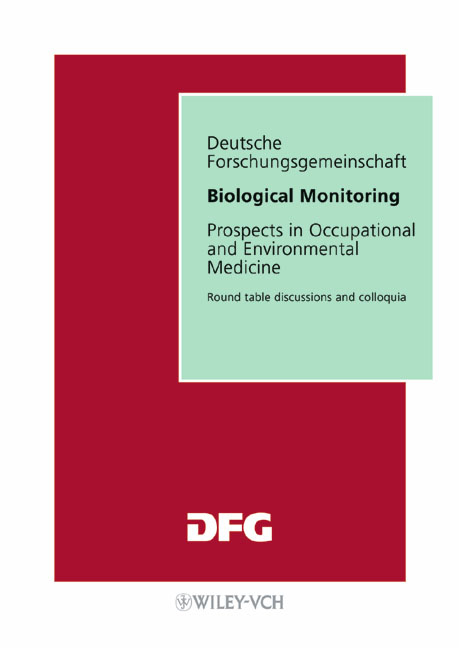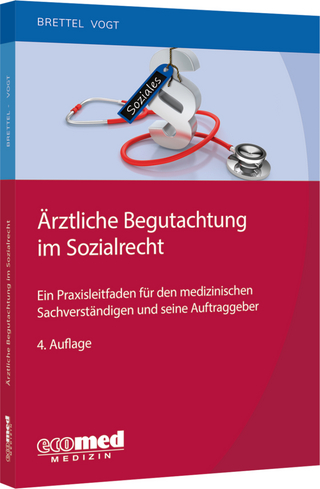
Biological Monitoring
Wiley-VCH (Verlag)
978-3-527-27795-7 (ISBN)
- Titel ist leider vergriffen;
keine Neuauflage - Artikel merken
At the invitation of the Deutsche Forschungsgemeinschaft (DFG), a round-table discussion was held on 9 and 10 March 2000, dealing with future possibilities for biomonitoring in occupational and environmental medicine. Biomonitoring has reached a high standard in Germany over the past 30 years, not least due to the fact that the results of the Senate commission on materials hazardous to health at the workplace have been directly implemented as part of the jurisdiction relating to occupational safety.This book combines the expertise gathered from various areas within toxicology, occupational medicine, immunology and human genetics, right up to analysis and epidemiology. Throughout, the focus is on comprehensively determining the diagnostic validity of cytogenetic parameters as well as biochemical and biological effect markers for the prevention of illnesses resulting from harmful substances. Thus, the discussion allowed an initial exchange of ideas, pointing to future research, so as to maintain Germany's leading role in this important and rapidly expanding field. '...provides an excellent tutorial on the use of biological monitoring in occupational and environmental medicine...should be read by everyone involved with exposure analysis' - "Chemical Chemistry".
Foreword.I: THE IMPORTANCE OF BIOLOGICAL MONITORING.The Development and Importance of Biological Monitoring in the DFG and MAK Commission (D. Henschler).II: INTERNAL EXPOSURE AND HAEMOGLOBIN ADDUCTS.Biological Monitoring in Occupational and Environmental Medicine - The Present State of the Art and Future Prospects (J. Angerer).Metabolic Profiling - A Way of Better Understanding External and Internal Exposure to Organic Stubstances (A. Rettenmeier).Biological Monitoring of Arylamines and Nitroarenes (G. Sabbioni).III: DNA ADDUCTS.Genetic Cancer Susceptibility and DNA Adducts: Studies in Smokers and Coke Oven Workers (M. Rojas, et al.).The Detection of DNA Adducts in Biological Monitoring (W. Lutz & M. Maisch).32P-Postlabelling HPLC Analysis of DNA Adducts in Breast Tissue (W. Pfau).Studies of 8-Hydroxy-2'-Deoxyguanosine: A Biomarker for Oxidative DNA Damage in vivo? (B. Marczynski, et al.).IV: SUSCEPTIBILITY.Improved Methods of Phenotyping and Effect Monitoring for Evaluating the Risk to the Individual, using GSTT1 as an Example (E. Hallier).Genetic Polymorphisms of Sulfotransferases as Susceptibility Parameters (H. Glatt).Genotyping and Phenotyping, Using NAT2 as an Example (K. Golka & M. Blaszkewicz).New High-thoughput Technology in the Diagnostic Screening of Susceptibility Factors (R. Thier, et al.).V: CYTOGENETIC PARAMETERS.Biological Monitoring with Cytogenetic Methods (G. Obe, et al.).Examples of the Use of Three-colour Chromosome Painting in Cytogenetic Biomonitoring (E. Gebhart, et al.).The Comet Assay as a Biological Monitoring Test (G. Speit, et al.).VI: IMMUNOLOGY.Immunoglobulins as Markers of Long-term Exposure to Allergenic Substances (H. Drexler).Immunological Effects of Polymorphic Key Enzymes (J. Lewalter).VII: EPIDEMIOLOGY.Evaluation of Exposure in Epidemiological Studies (K. Ulm).Possibilities and Limitations of the Molecular Epidemiology of Workplace Exposures (K. Straif).VIII: SUMMARY (J. Angerer & H. Greim).Authors.
| Reihe/Serie | DFG-Publikationen |
|---|---|
| Verlagsort | Weinheim |
| Sprache | englisch |
| Maße | 170 x 240 mm |
| Gewicht | 427 g |
| Einbandart | Paperback |
| Themenwelt | Medizin / Pharmazie ► Medizinische Fachgebiete ► Arbeits- / Sozial- / Umweltmedizin |
| Naturwissenschaften ► Biologie | |
| Naturwissenschaften ► Chemie | |
| Schlagworte | Arbeitsmedizin • Umweltmedizin |
| ISBN-10 | 3-527-27795-1 / 3527277951 |
| ISBN-13 | 978-3-527-27795-7 / 9783527277957 |
| Zustand | Neuware |
| Informationen gemäß Produktsicherheitsverordnung (GPSR) | |
| Haben Sie eine Frage zum Produkt? |
aus dem Bereich


